Contacts
![]() A contact is a pointer object that holds the address of a non-Exchange mail recipient. Contacts are made visible in the Global Address List and, therefore, permit Exchange clients to send messages to non-Exchange mail users. This functionality assumes that the necessary connector or gateway is in place between the Exchange system and the foreign system, such as the Internet Mail SMTP Connector for sending and receiving mail from the Internet.
A contact is a pointer object that holds the address of a non-Exchange mail recipient. Contacts are made visible in the Global Address List and, therefore, permit Exchange clients to send messages to non-Exchange mail users. This functionality assumes that the necessary connector or gateway is in place between the Exchange system and the foreign system, such as the Internet Mail SMTP Connector for sending and receiving mail from the Internet.
 Creating a Contact
Creating a Contact
![]() Like other objects, contacts are created using the Active Directory Users and Computers tool. When creating a contact, you must be prepared to select the type of e-mail address to create and to enter the foreign e-mail address. The standard options for the types of foreign addresses are as follows:
Like other objects, contacts are created using the Active Directory Users and Computers tool. When creating a contact, you must be prepared to select the type of e-mail address to create and to enter the foreign e-mail address. The standard options for the types of foreign addresses are as follows:
-
 Custom address
Custom address -
 X.400 address
X.400 address -
 Microsoft Mail address
Microsoft Mail address -
 SMTP address
SMTP address -
 cc:Mail address
cc:Mail address -
 Lotus Notes address
Lotus Notes address -
 Novell GroupWise address
Novell GroupWise address
![]() Exercise 5.7 walks you through the creation of this type of recipient.
Exercise 5.7 walks you through the creation of this type of recipient.
-
 Choose Start > Programs > Administrative Tools > Active Directory Users And Computers.
Choose Start > Programs > Administrative Tools > Active Directory Users And Computers. -
 From the Action menu, point to New, and select Contact.
From the Action menu, point to New, and select Contact. -
 Enter the full name and display name of the user for whom you want to create a contact object, and then click Next.
Enter the full name and display name of the user for whom you want to create a contact object, and then click Next. -
 Make sure the alias is correct, and then click Modify.
Make sure the alias is correct, and then click Modify. -
 From the list of address types in the New E-mail Address dialog that appears, select the type of e-mail address you want to create for the user, and click OK.
From the list of address types in the New E-mail Address dialog that appears, select the type of e-mail address you want to create for the user, and click OK. -
 On the General page of the Internet Address Properties dialog that opens, enter the e-mail address for the user.
On the General page of the Internet Address Properties dialog that opens, enter the e-mail address for the user. -
 Click Next to go on.
Click Next to go on. -
 A summary screen is then displayed asking you to confirm your choices. If you want to change any of the settings, you can use the Back button to do so. Once you are satisfied with your choices, click Finish to create the new contact object.
A summary screen is then displayed asking you to confirm your choices. If you want to change any of the settings, you can use the Back button to do so. Once you are satisfied with your choices, click Finish to create the new contact object.
 Properties of a Contact
Properties of a Contact
![]() The properties of a contact are very similar to those of a standard Exchange mailbox. The main difference is that the attributes dealing directly with the capabilities or restrictions of a mailbox are not available. For example, you cannot set storage limits on a contact since there is no storage on the Exchange server to limit. In addition, you cannot configure protocol settings for a contact.
The properties of a contact are very similar to those of a standard Exchange mailbox. The main difference is that the attributes dealing directly with the capabilities or restrictions of a mailbox are not available. For example, you cannot set storage limits on a contact since there is no storage on the Exchange server to limit. In addition, you cannot configure protocol settings for a contact.
Public Folder Recipients
![]() A public folder is a sharable container of information. It is a recipient object because, in addition to being able to view information in it, users can send information to it.
A public folder is a sharable container of information. It is a recipient object because, in addition to being able to view information in it, users can send information to it.
![]() Like mailboxes, public folders are created and stored on a specific home server. But because users on different servers and in different sites could need access to that public folder, you can configure public folders to be copied automatically to other Exchange servers. This is called replication, and each copy of the same public folder is called a replica.
Like mailboxes, public folders are created and stored on a specific home server. But because users on different servers and in different sites could need access to that public folder, you can configure public folders to be copied automatically to other Exchange servers. This is called replication, and each copy of the same public folder is called a replica.
![]() While the other recipients are created from Active Directory Users and Computers, public folders are created and managed using either a Microsoft Exchange client application (such as Outlook) or through the Exchange System Manager snap-in. All properties of a public folder are available for management within System Manager, and many are also available using an Exchange client. This allows users to take over much of the management of public folders.
While the other recipients are created from Active Directory Users and Computers, public folders are created and managed using either a Microsoft Exchange client application (such as Outlook) or through the Exchange System Manager snap-in. All properties of a public folder are available for management within System Manager, and many are also available using an Exchange client. This allows users to take over much of the management of public folders.
![]() The creation and configuration of public folders is covered in detail in Chapter 6, “Using Public Folders.”
The creation and configuration of public folders is covered in detail in Chapter 6, “Using Public Folders.”
Basic Management of Recipient Objects
![]() Even after they have been created, recipient objects still require care from administrators. Some of the basic management activities are as follows:
Even after they have been created, recipient objects still require care from administrators. Some of the basic management activities are as follows:
-
 Using templates for recipient creation
Using templates for recipient creation -
 Filtering a recipient
Filtering a recipient -
 Finding a recipient
Finding a recipient -
 Moving a mailbox
Moving a mailbox -
 Using address lists
Using address lists
![]() Each of these activities is covered briefly in the following discussions.
Each of these activities is covered briefly in the following discussions.
 Using Templates for Recipient Creation
Using Templates for Recipient Creation
![]() A template is a pattern that can be used to more efficiently create something—in this case, a recipient object. A template recipient, or multiple template recipients, can be created with the desired default values. These default values can then be used when creating actual recipient objects.
A template is a pattern that can be used to more efficiently create something—in this case, a recipient object. A template recipient, or multiple template recipients, can be created with the desired default values. These default values can then be used when creating actual recipient objects.
![]() Any object can be used as a template. A simple method is to create an object, such as a user, that holds all of the default attribute settings you desire. Once the template is created, use it by highlighting it and then selecting the Copy command from the Action menu of the Active Directory Users and Computers tool. The New Object Wizard will open, just as when you create a new object, except that all of the default information configured in the template will already appear in the new object. The exception is that no matter what type of template object you use, the first name, last name, display name, alias name, directory name, and e-mail address are not copied to the new recipient objects created from the template.
Any object can be used as a template. A simple method is to create an object, such as a user, that holds all of the default attribute settings you desire. Once the template is created, use it by highlighting it and then selecting the Copy command from the Action menu of the Active Directory Users and Computers tool. The New Object Wizard will open, just as when you create a new object, except that all of the default information configured in the template will already appear in the new object. The exception is that no matter what type of template object you use, the first name, last name, display name, alias name, directory name, and e-mail address are not copied to the new recipient objects created from the template.
| Note |
|
 Filtering a Recipient
Filtering a Recipient
![]() By default, all types of recipients are shown in Active Directory Users and Computers, including public folders. You can filter that view with the View menu so that only select types of recipients are shown. Filtering your recipient view can be useful if you are looking for a specific recipient and the list based on recipient type is not very long, or if you need to select all the recipients of a certain type.
By default, all types of recipients are shown in Active Directory Users and Computers, including public folders. You can filter that view with the View menu so that only select types of recipients are shown. Filtering your recipient view can be useful if you are looking for a specific recipient and the list based on recipient type is not very long, or if you need to select all the recipients of a certain type.
![]() In addition to using the View menu, you can also apply more advanced filters that let you view sets of objects according to selected attribute settings. To apply a filter, select a container holding Exchange recipients in Active Directory Users and Computers (such as Users), and choose Filter Options from the View menu. This opens the Filter Options dialog shown in Figure 5.12.
In addition to using the View menu, you can also apply more advanced filters that let you view sets of objects according to selected attribute settings. To apply a filter, select a container holding Exchange recipients in Active Directory Users and Computers (such as Users), and choose Filter Options from the View menu. This opens the Filter Options dialog shown in Figure 5.12.
![]() The default setting is to view recipients of all types. Click the Show Only The Following Types Of Objects option, and check the types of recipients you want to view. When you click OK, only those types of recipients are displayed in the Users container. The Filter Options dialog also lets you specify how many recipients should be displayed per folder.
The default setting is to view recipients of all types. Click the Show Only The Following Types Of Objects option, and check the types of recipients you want to view. When you click OK, only those types of recipients are displayed in the Users container. The Filter Options dialog also lets you specify how many recipients should be displayed per folder.
 Finding a Recipient
Finding a Recipient
![]() Active Directory Users and Computers provides a recipient search tool with sophisticated search criteria. Open this tool by selecting the Find command in the Action menu. This command opens the Find Users, Contacts, and Groups window, shown in Figure 5.13.
Active Directory Users and Computers provides a recipient search tool with sophisticated search criteria. Open this tool by selecting the Find command in the Action menu. This command opens the Find Users, Contacts, and Groups window, shown in Figure 5.13.
![]() Use the Find field to specify what types of objects you want to find. The default is to find users, contacts, and groups. Use the In field to specify the container in which you want to perform the search. The default is to search in the Users container. Enter any part of a name or description, and click Find Now to begin the search. The Find window expands to display the results. You can manipulate objects in the Find window just as you would in the main Active Directory Users and Computers window by right-clicking them to access their shortcut menus.
Use the Find field to specify what types of objects you want to find. The default is to find users, contacts, and groups. Use the In field to specify the container in which you want to perform the search. The default is to search in the Users container. Enter any part of a name or description, and click Find Now to begin the search. The Find window expands to display the results. You can manipulate objects in the Find window just as you would in the main Active Directory Users and Computers window by right-clicking them to access their shortcut menus.
![]() There are also a few advanced options you can use to narrow your search. The Exchange tab in the Find window lets you specify that you want to view only Exchange recipients in your search results and even lets you set the specific types of recipients you want displayed.
There are also a few advanced options you can use to narrow your search. The Exchange tab in the Find window lets you specify that you want to view only Exchange recipients in your search results and even lets you set the specific types of recipients you want displayed.
 Moving a Mailbox
Moving a Mailbox
![]() Physically, mailboxes and their contents reside on their home server. Mailboxes can be moved to other servers or to other mailbox stores on the same server. This is done through Active Directory Users and Computers. Simply highlight the user whose mailbox you want to move, and select the Exchange Tasks command from the Action menu. On the first screen, select the Move Mailbox option. The Exchange Task Wizard will then step you through choosing a new server and storage group for the mailbox, as seen in Figure 5.14. When you finish the wizard, the mailbox is moved.
Physically, mailboxes and their contents reside on their home server. Mailboxes can be moved to other servers or to other mailbox stores on the same server. This is done through Active Directory Users and Computers. Simply highlight the user whose mailbox you want to move, and select the Exchange Tasks command from the Action menu. On the first screen, select the Move Mailbox option. The Exchange Task Wizard will then step you through choosing a new server and storage group for the mailbox, as seen in Figure 5.14. When you finish the wizard, the mailbox is moved.
![]() When you move a mailbox, the size of the mailbox can increase. When a message is sent to multiple recipients in the same storage group, Exchange stores only one copy of the message on the server and gives all the recipients on that server a pointer to that single copy. This is called single-instance storage. But when a mailbox is moved outside the storage group, the single-instance storage for that mailbox is lost in the new location because each message must be copied there. For example, suppose 10 mailboxes take up 55 MB of disk space in the Private Information Store. Each mailbox has five messages of 1 MB and a pointer to five single-instance messages of 1 MB. If those 10 mailboxes were moved to another server, the single-instance storage would be lost, and each mailbox would have 10 MB of storage. The Private Information Store on the new server would increase by 100 MB.
When you move a mailbox, the size of the mailbox can increase. When a message is sent to multiple recipients in the same storage group, Exchange stores only one copy of the message on the server and gives all the recipients on that server a pointer to that single copy. This is called single-instance storage. But when a mailbox is moved outside the storage group, the single-instance storage for that mailbox is lost in the new location because each message must be copied there. For example, suppose 10 mailboxes take up 55 MB of disk space in the Private Information Store. Each mailbox has five messages of 1 MB and a pointer to five single-instance messages of 1 MB. If those 10 mailboxes were moved to another server, the single-instance storage would be lost, and each mailbox would have 10 MB of storage. The Private Information Store on the new server would increase by 100 MB.
![]() Mailboxes might be moved for several reasons:
Mailboxes might be moved for several reasons:
-
 To balance the load between servers
To balance the load between servers -
 To move mailboxes to a server that is on the same local area network as the mailbox owners
To move mailboxes to a server that is on the same local area network as the mailbox owners -
 To take a server down for maintenance reasons and still allow users access to their mailboxes
To take a server down for maintenance reasons and still allow users access to their mailboxes
![]() Because groups and contacts are primarily logical entities, they are not tied to any one specific Exchange server. You can move these objects into different containers within the Active Directory organization if needed.
Because groups and contacts are primarily logical entities, they are not tied to any one specific Exchange server. You can move these objects into different containers within the Active Directory organization if needed.
 Using Address Lists
Using Address Lists
![]() Users on your network normally search for other users using the Global Address List (GAL), which contains all messaging recipients in an organization. If your network contains a large number of recipients, searching through the GAL for a specific recipient can become a daunting task. Fortunately, you can configure your own address lists that limit the scope of recipients included in the list.
Users on your network normally search for other users using the Global Address List (GAL), which contains all messaging recipients in an organization. If your network contains a large number of recipients, searching through the GAL for a specific recipient can become a daunting task. Fortunately, you can configure your own address lists that limit the scope of recipients included in the list.
Default Address Lists
![]() Exchange Server 2003 comes with several default address lists built in. When a user opens their address list in a client application, they can choose which address list to view. Table 5.1 shows the default address lists.
Exchange Server 2003 comes with several default address lists built in. When a user opens their address list in a client application, they can choose which address list to view. Table 5.1 shows the default address lists.
|
|
|
|---|---|
|
|
|
|
|
|
|
|
|
|
|
|
|
|
|
Custom Address Lists
![]() Exchange Server 2003 also lets you create your own custom address lists based on most of the fields available on recipient objects. For example, you could create an address list that showed only the users based in a certain city or in a certain department. Address lists are created in the Recipients container in System Manager, as shown in Figure 5.15.
Exchange Server 2003 also lets you create your own custom address lists based on most of the fields available on recipient objects. For example, you could create an address list that showed only the users based in a certain city or in a certain department. Address lists are created in the Recipients container in System Manager, as shown in Figure 5.15.
![]() All address lists must be created inside other address lists. To create a top-level address list, create it inside the All Address Lists list. Since address lists can be nested, you can get pretty sophisticated in creating an address list structure. For example, suppose that you wanted your users to be able to quickly locate your corporate executives. You might first create an address list called Corporate Executives. Under that you could then create additional address lists named Board Members, Executive Secretaries, and Vice Presidents. Under these lists you could go even further by creating lists for geographical location. Figure 5.16 shows a hierarchy like this example. You could alternatively create address lists that are nested by state, city, and building if you desired.
All address lists must be created inside other address lists. To create a top-level address list, create it inside the All Address Lists list. Since address lists can be nested, you can get pretty sophisticated in creating an address list structure. For example, suppose that you wanted your users to be able to quickly locate your corporate executives. You might first create an address list called Corporate Executives. Under that you could then create additional address lists named Board Members, Executive Secretaries, and Vice Presidents. Under these lists you could go even further by creating lists for geographical location. Figure 5.16 shows a hierarchy like this example. You could alternatively create address lists that are nested by state, city, and building if you desired.
![]() When you create a new address list, a dialog box opens that lets you name the list and set up filter rules that define the recipients contained in the list. You can set up the filter rules when you create the list or go back and do it later by opening the property pages for the list. When we are creating a nest of address lists, we often find it helpful to go ahead and create the structure by simply creating and naming the lists and then going back later to set up the filter rules.
When you create a new address list, a dialog box opens that lets you name the list and set up filter rules that define the recipients contained in the list. You can set up the filter rules when you create the list or go back and do it later by opening the property pages for the list. When we are creating a nest of address lists, we often find it helpful to go ahead and create the structure by simply creating and naming the lists and then going back later to set up the filter rules.
![]() You create filter rules using an interface much like the one used for finding recipients in Active Directory that we discussed earlier in the chapter (see Figure 5.17). Use the General tab of this dialog box to choose the types of recipients you want included on the list. Use the Storage tab to specify the server on which mailboxes or public folders are stored. Use the Advanced tab to restrict membership on the list by selecting criteria for specific fields for a recipient, such as their city, department, or any custom attribute.
You create filter rules using an interface much like the one used for finding recipients in Active Directory that we discussed earlier in the chapter (see Figure 5.17). Use the General tab of this dialog box to choose the types of recipients you want included on the list. Use the Storage tab to specify the server on which mailboxes or public folders are stored. Use the Advanced tab to restrict membership on the list by selecting criteria for specific fields for a recipient, such as their city, department, or any custom attribute.
Offline Address Lists
![]() Offline address lists are typically used by people who are not always connected to the Exchange network. Offline address lists are copies of online address lists that are stored on a user’s local computer using an .oab extension. By default, the Default Global Address List is used to generate a Default Offline Address List. You can also create custom offline address lists by right-clicking the Offline Address Lists container in System Manager (refer to Figure 5.15) and choosing New Offline Address List. When creating the new offline address list, you will specify the list’s name, the server that will store the new list, and any address lists (default or custom) that will be used to generate the new offline address list.
Offline address lists are typically used by people who are not always connected to the Exchange network. Offline address lists are copies of online address lists that are stored on a user’s local computer using an .oab extension. By default, the Default Global Address List is used to generate a Default Offline Address List. You can also create custom offline address lists by right-clicking the Offline Address Lists container in System Manager (refer to Figure 5.15) and choosing New Offline Address List. When creating the new offline address list, you will specify the list’s name, the server that will store the new list, and any address lists (default or custom) that will be used to generate the new offline address list.
Recipient Update Service
![]() The Recipient Update Service (RUS) is a component of the System Attendant service that is responsible for building and maintaining address lists. RUS polls Active Directory for updated recipient information on a predefined schedule (every one minute, by default) and updates address lists based on any new information. The RUS is also responsible for updating the e-mail addresses of any recipients that are attached to a recipient policy. Recipient policies are covered in Chapter 10, “Administration and Maintenance.”
The Recipient Update Service (RUS) is a component of the System Attendant service that is responsible for building and maintaining address lists. RUS polls Active Directory for updated recipient information on a predefined schedule (every one minute, by default) and updates address lists based on any new information. The RUS is also responsible for updating the e-mail addresses of any recipients that are attached to a recipient policy. Recipient policies are covered in Chapter 10, “Administration and Maintenance.”
![]() The Recipient Update Services container in System Manager is shown in Figure 5.18. By default, two RUS objects are created:
The Recipient Update Services container in System Manager is shown in Figure 5.18. By default, two RUS objects are created:
-
 The Recipient Update Service (Enterprise Configuration) object updates the e-mail addresses of objects in the configuration partition of Active Directory. This includes objects such as the Information Store, MTA, and System Attendant.
The Recipient Update Service (Enterprise Configuration) object updates the e-mail addresses of objects in the configuration partition of Active Directory. This includes objects such as the Information Store, MTA, and System Attendant. -
 One Recipient Update Service (installation Active Directory domain) object exists for each Active Directory domain that contains an Exchange server. This RUS object updates the e-mail addresses for recipients found in the domain partition of Active Directory, including users, groups, public folders, and contacts. This RUS object also updates address lists based on changes to recipient objects in a domain.
One Recipient Update Service (installation Active Directory domain) object exists for each Active Directory domain that contains an Exchange server. This RUS object updates the e-mail addresses for recipients found in the domain partition of Active Directory, including users, groups, public folders, and contacts. This RUS object also updates address lists based on changes to recipient objects in a domain.
![]() Even though the RUS runs automatically, you can also update address lists manually using one of the following two commands, which are available by right-clicking a specific address list:
Even though the RUS runs automatically, you can also update address lists manually using one of the following two commands, which are available by right-clicking a specific address list:
-
 The Update Now command updates the address list with any new changes in recipient information.
The Update Now command updates the address list with any new changes in recipient information. -
 The Rebuild command rebuilds the entire membership of the address list.
The Rebuild command rebuilds the entire membership of the address list.
![]() In addition, you can modify the parameters of the RUS object itself by right-clicking it and choosing Properties. The following four properties are available:
In addition, you can modify the parameters of the RUS object itself by right-clicking it and choosing Properties. The following four properties are available:
-
 The domain serviced by the RUS. This is not directly modifiable.
The domain serviced by the RUS. This is not directly modifiable. -
 The server in the domain responsible for generating and updating address lists for the domain.
The server in the domain responsible for generating and updating address lists for the domain. -
 The domain controller that the server connects to for updated Active Directory information.
The domain controller that the server connects to for updated Active Directory information. -
 The update interval at which the RUS will run. The Run Always option sets the RUS to run at its default—every one minute.
The update interval at which the RUS will run. The Run Always option sets the RUS to run at its default—every one minute.
Summary
![]() Recipients are Active Directory objects that are used to reference resources that can receive messages. The four main types of recipients are as follows:
Recipients are Active Directory objects that are used to reference resources that can receive messages. The four main types of recipients are as follows:
-
 Users
Users -
 Groups Contacts
Groups Contacts -
 Public folders
Public folders
![]() A user is an Active Directory object that usually represents a person with an Exchange mailbox. A mailbox-enabled user has an associated mailbox in a Private Information Store on an Exchange server. Each user mailbox is a private storage area that allows an individual user to send, receive, and store messages. A mail-enabled user is one who has an e-mail address and can receive, but not send, messages.
A user is an Active Directory object that usually represents a person with an Exchange mailbox. A mailbox-enabled user has an associated mailbox in a Private Information Store on an Exchange server. Each user mailbox is a private storage area that allows an individual user to send, receive, and store messages. A mail-enabled user is one who has an e-mail address and can receive, but not send, messages.
![]() A group is a container into which you can place other recipients. Recipients in a group automatically inherit that group’s permissions and rights. Exchange uses mail-enabled groups to form distribution lists. Messages sent to a group are redirected and sent to each member of the group. These groups allow users to send messages to multiple recipients without having to address each recipient individually.
A group is a container into which you can place other recipients. Recipients in a group automatically inherit that group’s permissions and rights. Exchange uses mail-enabled groups to form distribution lists. Messages sent to a group are redirected and sent to each member of the group. These groups allow users to send messages to multiple recipients without having to address each recipient individually.
![]() Query-based distribution groups are a new type of distribution group in Exchange Server 2003 that allows Exchange administrators to create distribution groups that maintain their group membership dynamically. Once the LDAP query has successfully been created for the query-based distribution group, the applicable objects (those that meet the filter query criteria) will automatically be members of the query-based distribution group. Every time an e-mail message is sent to a query-based distribution group, the LDAP query is performed to determine the current group membership to which the message should be expanded.
Query-based distribution groups are a new type of distribution group in Exchange Server 2003 that allows Exchange administrators to create distribution groups that maintain their group membership dynamically. Once the LDAP query has successfully been created for the query-based distribution group, the applicable objects (those that meet the filter query criteria) will automatically be members of the query-based distribution group. Every time an e-mail message is sent to a query-based distribution group, the LDAP query is performed to determine the current group membership to which the message should be expanded.
![]() A contact is a pointer to an e-mail address for a non-Exchange recipient. Contacts are most often used for connecting your organization to foreign messaging systems, such as Microsoft Mail, Lotus Notes, or the Internet. As an administrator, you would create contacts so that frequently used e-mail addresses are available in the Global Address List as real names.
A contact is a pointer to an e-mail address for a non-Exchange recipient. Contacts are most often used for connecting your organization to foreign messaging systems, such as Microsoft Mail, Lotus Notes, or the Internet. As an administrator, you would create contacts so that frequently used e-mail addresses are available in the Global Address List as real names.
![]() A public folder contains information that is shared among a group of people. Public folders can contain e-mail messages, forms, word-processing documents, spreadsheet files, and files of many other formats.
A public folder contains information that is shared among a group of people. Public folders can contain e-mail messages, forms, word-processing documents, spreadsheet files, and files of many other formats.
![]() With the exception of public folders, all recipient objects are created and managed using the Active Directory Users and Computers utility. When you create a new user, you are automatically given the chance to create a mailbox for that user. You can also create mailboxes for existing users. Contacts and groups are usually made mail-enabled when they are created.
With the exception of public folders, all recipient objects are created and managed using the Active Directory Users and Computers utility. When you create a new user, you are automatically given the chance to create a mailbox for that user. You can also create mailboxes for existing users. Contacts and groups are usually made mail-enabled when they are created.
![]() Recipient objects are generally configured with property pages, which are groups of attributes that pertain to the object. Other Exchange-related tasks can be accessed through the Exchange Tasks command in the Action menu of Active Directory Users and Computers.
Recipient objects are generally configured with property pages, which are groups of attributes that pertain to the object. Other Exchange-related tasks can be accessed through the Exchange Tasks command in the Action menu of Active Directory Users and Computers.
![]() Public folders are created and managed using either an Exchange client or the System Manager snap-in for Exchange.
Public folders are created and managed using either an Exchange client or the System Manager snap-in for Exchange.


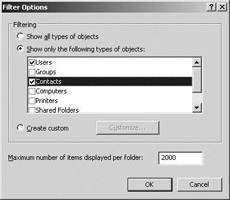
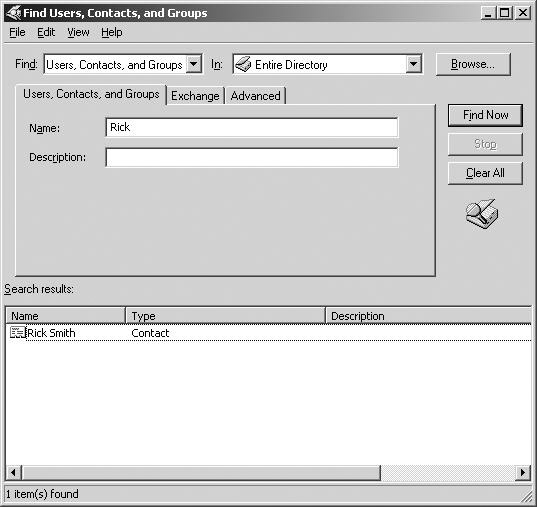
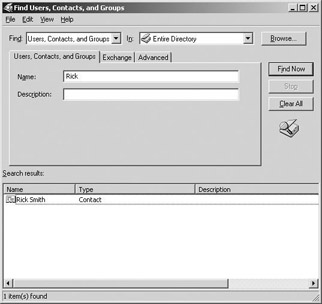
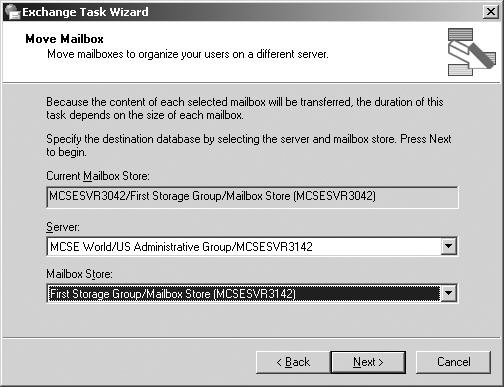
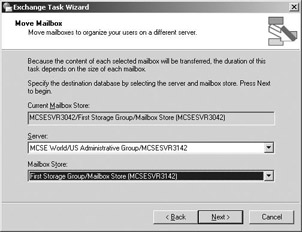
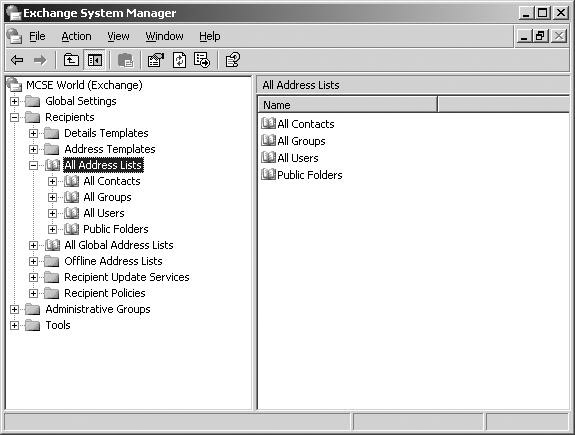
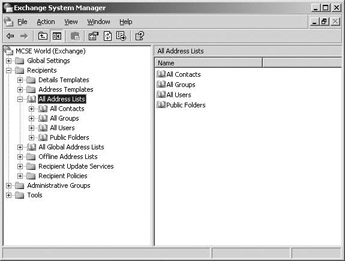
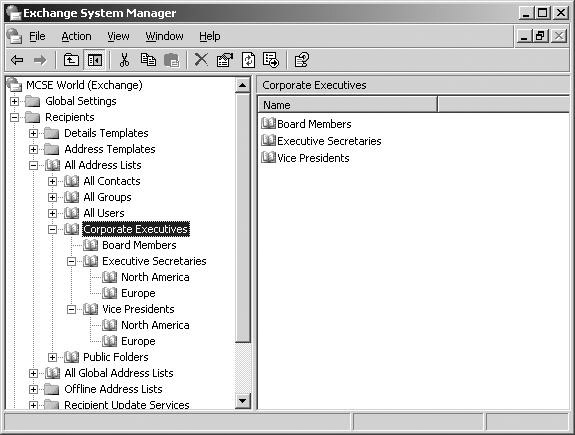
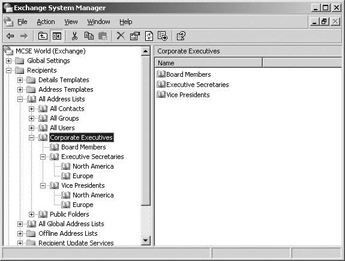

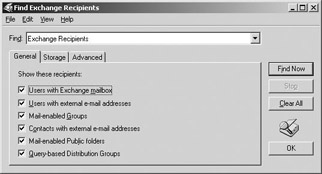
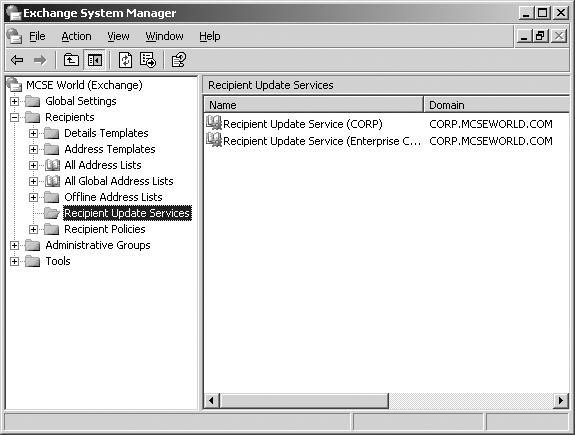
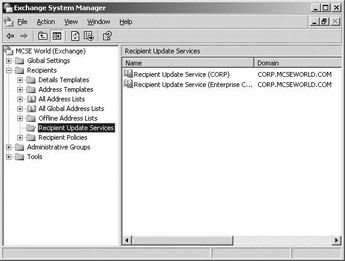
0 comments
Post a Comment